
Flat Work Ironer
Get Price Quote
flat work ironer / calander ironing with roller heating—single roller no need of compressor electric or steam heated

Flat Work Ironer
Get Price Quote
1 Piece (MOQ)
Best Deals from Flatwork Iron

Flatwork Ironer
Get Price Quote
Microprocessor control, finger guard protection, user-friendly system, frequency inverter, standardized automatic cooling down mechanism and exhaust functions are some of the striking features of our Flatwork Ironer. With extremely low maintenance, our highly energy efficient product helps gain maximum output results in terms of producing superior linen finishes. Our product is well equipped with a mirror finished cylinder, safe hand protection board, etc. Details : Our Flat Work Ironers produces high quality linen finishes easily and efficiently. The cylinder is mirror polished and supported by heavy-duty lubricated bearings. A highly sensitive hand protection board ensures ultimate safety in each phase of the ironing process. Our frequency conversion speed adjustment system allows for a continual even flow of speed which brings more energy saving. Speciality : Microprocessor control Finger Guard Protection User friendly control Frequency Inverter Standard automatic cool down Exhaust system Advantages : High productivity Minimum maintenance High quality finishing. Less energy consumption Cost effective. Model : Single roller, Double Roller, Three roller, Four Roller Size : 800 mm roller dia, 2500mm, 2800mm, 3000mm width.

Flatwork Ironer
835,000 Per Piece
2 Piece (MOQ)
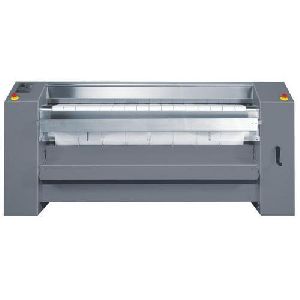
Commercial Flatwork Ironer
75,000 Per Piece

Flatwork Ironer
Get Price Quote
We are offering flatwork ironer. fabtech flat work ironer, specially designed in return feed type, single or multiple rolls. Air suspended polished ironing chest machined fabricated with pneumatic raising & lowering, adjustable pressure across the entire rolls perfectly fabricated rolls ensure consistent bed contact. Complete with built-in electric control panel, drive motor, powerful suction blower, feed conveyor, fingure guard, steel wool padding, feed and collection tables with variable speed. Ideally suitable for drying and fine ironing of all flat linen like bed sheet, pillow cases, napkins and table clothes etc.

Electric and Steam Flat Work Ironer
Get Price Quote
This is a unique machine to dry and iron all at material such as Bed Sheets, Pillow covers, Table Cloth & Napkins directly after Hydro extraction to produce a quality finish. Excellent design of roller angle ensures greater area of contact to give higher output and increase productivity. This machine is fe from the front, with a front return type miro processor control and inverter drives are present to regulate speed up to 10 mtrsmin. Feeding and heating belts are imported to ensure best quality and long life. Very low power and stream consumption compacyt design of front head and return requires working space only on the front side This machine is equipped with digital compact design of front head and return requires working space only on the front side. This machine is Equipped with digital temperature indicator and digital speed indicator. Hand safety guard and emergency stop are provided to ensure safe working conditions. Variable speed drive of different type of fabrics and reversing the direction are also possible. specially designed blower to remove excess moisture. Available in 2 standard sizes. Machines of higher evaporation ratio with 600 mm also available.

Fully Automatic Flat Work Ironer
600,000 Per Piece
1 Piece(s) (MOQ)
flatwork ironing machine for ironing bed sheets, quilt cover, tablecloth.stainless steel roller, large diameter φ800mm, roller thickness 4mm, international safety standard.high-quality steel carbon structures, strong and durable.finger protection and emergency stop for more safety.sealed rotary joints prevent leakage, safety and reliability, save energy.pressure roll with guiding ribbons, superior ironing quality, antistatic ironing belts.variable frequency, variable speed, according to fabric, moisture, steam supply etc.three-phase electrical system, overload protection, voltage and short circuit protection, emergency stop switch.ironing direction: front in back out / front in front out roller quantity, one, two, three, four, you can choose.heating:steamer
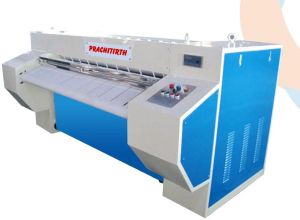
Flat Work Ironer
Get Price Quote
1 Piece(s) (MOQ)
The prachitirth flat work ironer is used to dry and iron all flat articles such as bed sheet, pillow covers, table cloth, napkins etc. Directly after the extraction process to produce a quality finish. The feeding and heating belts are completely imported quality. These belts do not absorb moisture and prevent the transfer of any marks to the articles being processed. Heat is transferred to the articles being processed via a heated cylinder manufactured out of complete boiler grade (for steam heated machines). The unique design of the cylinder enables the transfer of heat with a high pressure on the articles thereby creating a higher efficiency while can summing minimal energy. Heating of the cylinder is via steam or electricity. Very low power and steam consumption and a compact front feed, front return design ensure very minimal space consumption. A powerful blower ensures maximum removal of the moist air created within the machine. The electrical panel is equipped with a digital temperature indicator and digital speed indicator. A hand safety guard through the length of the cylinder and emergency stop buttons are provided to ensure a safe working. A variable speed drive for different types of fabrics and reversing of the cylinder are standard.
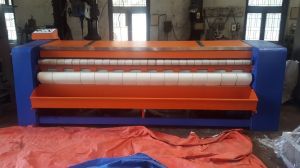
Flat Work Ironer
Get Price Quote
WITII HEATED CHEST & REAR RETURN. Roller having large diameter with moving ironing chest, Large diameter ensuring a long contact surface, flexibility for addition of another roll, Powerful suction for fast drying Finger guard for operator safety, felixibility for changing of roller speed through 'VFD. GUARANTEED IRONING SHINE COUPLED WITH CONVENIENCE OPTIONAL : IMPORTED SPRING PADDING

Flat Work Ironer
275,000 Per Piece
Flat bed press megha flat bed presses require two button operations to close the press for operator hand safety. The presses are also provided with an emergency off switch again for safety. The presses are provided with foot switches where required for the commencement of vacuuminjection of steam. These are suitable for table covers, pillow covers, napkins, kitchen staff uniform. The suction feature, quality padding and teflon lining on heat guarantee fine finishing. Technical specifications: description a utility laundry press air pressure (bar) â“6 steam quantity -40kghr dimensions (wxdxh) (open size 1340x1100x1350mm net weight - 460 kgs
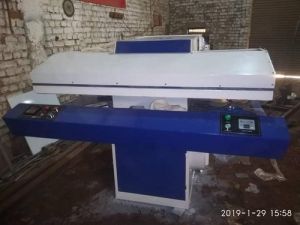
Flatwork Ironer Machine
350,000 Per Piece
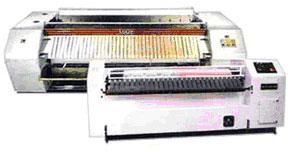
Flatwork Ironer Machine
Get Price Quote
We are a notable Flat Work Ironer / Calender Machine Manufacturer, Exporter and Supplier. Best quality raw materials are used in manufacturing our Flatwork Ironer Machines, such as N.S. pipe, S.S. Sheet, M.S. sheet, pneumatic machine and electric heater. We offer Flat Work Ironer / Calender Machine in electric and steam type, which serve varied applications. Why Our Flat Work Ironer / Calender Machine? Pneumatic raising & lowering of the chestsRoller with moisture suction & variable speedPowerful suction: Individual direct mounted centrifugal blower on to the roller quickly removes moistureFailsafe finger guard stops the machine instantly

Flat Work Ironer (Calendering Machine)
Get Price Quote
We are appreciated for offering highly efficient Flatwork Ironer to the clients. Manufactured using high-grade components, the Flatwork Ironers deliver high efficiency and performance. Moreover, Our Flatwork Ironer or Calendering Machine is widely appreciated for its reliability and durability. We offer the Flat Work Ironer Machine in different specifications to meet the requirements of the clients. Our Flatwork Ironer can be availed at market leading prices from us. Special Features Pneumatic raising and lowering of the chests Roller with moisture suction & variable speed Auto timed, Auto temperature Control, Variable Frequency Drive Control Powerful suction : Individual direct mounted centrifugal blower on to the roller quickly removes moisture It offers a dramatic saving of time labor ideal for pressing of sheets, napkins, table lines, pillow cover and any type of flat line etc. made easy Failsafe finger guard stops the machine instantly Variety Single or Multi Roller Electric or steam heated type

Flat Work Ironer
Get Price Quote
Our products are formed under the supervisor of experienced quality control managers utilizing only premium materials and the latest technologies. We are staffed with dexterous team members and packaging experts; they ensure that the products are completely safe from the external damaging factors, and this is done by using quality-packaging material.Details : Heat proof padding for longer life Finger guard protection and emergency stop Electrical heated Front feed and return type The ironing chest is nickel plated to protect from rustin Flat Work Ironer The MFWIE2 series ironer is an industrial chest type ironer with fixed roll and movable chest. A uniform pressure throughout the entire width ensures high ironing quality. Heating can be in steam. A simple and reliable drive ensures easy operation and hassle free maintenance. The imported spring press fitting comes standard with all models and ensures a uniform roll and chest contact. The feeding belts are completely imported and are of imported Nomex quality. These belts do not absorb moisture and prevent the transfer of any marks to the articles being processed. A frequency controlled motor optimises the speed and productivity. All MFWIE2 series come standard with a finger guard protection further enhancing operator safety. Removal of moisture is controlled by an adjustable suction fan. Insulation provided to ensure minimum heat losses and increases thermal output considerably. Standard Features : Variable speeds depend on the cloth to be Ironed Front feed and return type Imported padding and feed belts Occupies minimal floor area Requires less steam Operator safety Features : Dependability Longer service life Excellent heating Noted operation Optimum performance Stability User-friendly Rugged construction Low maintenance requirements Negligible energy consumption

Flat Work Ironer
425,000 Per piece
1 piece (MOQ)

Flat Work Ironer
190,000 Per Piece
1 Piece (MOQ)

Flatwork Ironer
Get Price Quote
The flatwork ironer ECH model series is a single roll industrial Electrical chest heated ironers for small institutions, boarding schools where space and budget is limited.

fine tuning flatwork ironer
Get Price Quote
And equipment malfunctioning at any step can lead to the need for rewash. With flatwork ironers, rewash can come in the form of stains, rips, or product with holes in it that went through the ironer or happened on the ironer. It shows up on the ironer because that’s the last thing that happens to the product before it goes to packaging or goes out the door to the customer. “One thing for sure, we know that rewash costs a lot of money,” says David Rovetto, a regional sales manager with Tingue. Rovetto shared 10 practical keys to focus on when it comes to ironer care and performance during an Association for Linen Management (ALM) educational session here called Squash the Rewash. PROPER CHEST CLEANING AND LUBRICATION Rovetto says that it doesn’t matter who the ironer manufacturer is, or the size of the machine, the chest underneath all of the padded rolls needs to be cleaned, and it should be lubricated. “Why lubricate it? So the product will flow through good, you will have good quality,” he says. “If it’s not lubricated and cleaned, you’re going to get more rejects. The sheet or tablecloth, whatever it may be, may go in great, but come out the back end looking bad because it was dragged across a dirty part of the chest.” There’s nothing more important than cleaning and lubricating your ironer chest at the beginning of each shift, according to Rovetto. Something that he encourages laundries to do is run a scouring pad at the beginning of the day. It doesn’t matter which kind of scouring pad, or what shape or size. The bottom line, he says, is to use something that will clean the ironer chest. “It’s like brushing your teeth,” says Rovetto. “If you don’t brush your teeth, you’re going to get buildup. That means rejects. It affects the longevity of the product that you buy. It’s expensive when you buy pads for your ironer.” Rovetto recommends scouring and waxing the chest at the start of the day and at lunch break. Run the scouring pad, run the wax cloth, restart the vacuum and the machine is good to go, he says. “Some people say, ‘I’m running two shifts.’ Second shift is really the beginning of the second day, if you will,” according to Rovetto. “This takes about five minutes to run a cleaning cloth through your ironer on both sides to give you a good scrub and wax added.” He recommends that healthcare laundries scrub and wax a couple times a day. If a plant processes food and beverage linens, it should happen every couple of hours. In food and beverage, it tends to be more sensitive to lubrication. There are all kinds of wax cloths, according to Rovetto, even wax cloths that used to be sheets. However, he says that’s not an ideal method because with the sheet, as soon as the wax melts, it’s going in both directions. “Some of it’s going on your ironer chest, and some of it is going on your pad,” he says. “You’re not trying to wax your pad; you’re trying to wax your ironer chest. The best wax cloth to get would be one that has a pocket, a barrier, put the wax down, put your flap back down, when it heats up, it goes straight onto the chest.” How much wax should be used? Rovetto recommends just one 8-ounce cup of wax. His advice is to wax sparingly, but often. “After you run the wax cloth, a lot of times people drag it across the floor, so it really wasn’t clean to begin with, draped on the side of the ironer,” Rovetto says. “I encourage you to hang it on racks so it can cool to be ready to use the next time.” He says to only add wax when the pocket is cold and limp. If powder wax is used, if the pocket is stiff, wax does not need to be added. “If you use paste, it’s never really going to get stiff, so you’re going to have to feel and see if you got a greasy residue to it,” Rovetto says. “Certainly you can look at your ironer chest when you run it to see if you have a little shine to it. With some waxes, you might even see a little steam going up in the air.” If a laundry has multiple ironers, Rovetto recommends alternating the ironer that is waxed first. He says that, for example, if a plant has three ironers and employees always start waxing on ironer one, ironer three might “get the short end of the stick” when it comes to wax coverage. “A lot of people I talk to say they can wax it in the morning, but they can’t get it at the morning and lunch break. But, they still have time to go behind the folder when called because of ironer number two to pull the jam out of the folder,” he says. “The linen probably wouldn’t do that if it wasn’t processed well because of the dirty chest or static. “It’s really something to think about when you think about cost to your ironer. A lot of time, it’s easy to get buy-in from the maintenance folks when you let them know you’ve been making their lives better with less cost to the ironer. The rest is history when it comes to rejects.” PROPER CHEST TEMPERATURES Rovetto says it’s important to run the ironer with proper chest temperature so that the wax works effectively. For example, steam-fueled ironers, which have probably a half-dozen waxes, powder and paste, under 350 F, they do a great job, he says. There would be no need to have a high-temperature wax for a steam ironer. “High-temp wax is definitely needed to cover thermal or self-contained units that go 370 (degrees) and up,” says Rovetto. “The reason is the wax won’t stay on the chest and it won’t perform at all and you’ll cook your pad so quickly, you’ll probably run through up to three times as many pads. It’s a nightmare.” He says that between 300 and 350 F is a great temperature for a steam ironer. If the temperature is below that, there will be linen travel issues, and the equipment may have trouble drying the linen. “And whoever your pad or ironer person is, certainly get them involved when that happens,” he recommends. WASHROOM CHEMISTRY AND PROPER PH Linen quality will be affected if the pH of the water gets too high or low, Rovetto says. “We work with the chemical folks sometimes to diagnose a linen quality issue that the customer is having, when they’re having a lot of headaches and can’t get good product to the ironer and don’t get a good finish at the end,” he says. The pH level is something Rovetto says that his staff checks. They use a small pH test kit, and the moment a client is having trouble with linen travel, they check that, along with other issues. “It does show up on the ironer. Whether or not it’s the proper weight, or whether or not it got washed with the correct formula, will show up on the ironer when it comes to that heat and the moisture in the product,” he says. PROPER MOISTURE RETENTION Whether it’s processing sheets, tablecloths, napkins, pillowcases, etc., Rovetto says that ironers are a lot like when he would leave his clothes in the dryer too long and they would have a rough, dry look. “Taking an iron to it at that point wasn’t going to do anything,” he says. In order to give the product a good finish, Rovetto says about 30% moisture is needed in the linen. He says that product can be too wet, but it’s probably better to be a little high on moisture than to be too low because it will look like the ironer didn’t press it out. “Often we’ll get involved when a customer lets us know they’re having a problem, and it’s just a matter of weighing some wet linen, get that linen dry, weigh that same 20 pieces or whatever and see what that percentage of moisture is,” Rovetto says. “You can’t go weigh 20 more sheets, because they’re newer, older or whatever. It has to be the same ones so we can get keyed in on what could be the problem.” Rovetto had a customer where all of the ironers were running well but then ran a different color through the equipment. The client didn’t have the right moisture in the product when it went through the ironer, and all of it looked bad. Then they went back to white, and the ironer put out a quality product. “Come to find out it was a different color that was involved that they don’t have a lot of inventory,” says Rovetto. “So, it’s not that we’re fixing equipment at that point, but sometimes that’s what we hear. ‘This ironer is great for everything, but it won’t run black mats. Whose fault is it?’” IMPORTANCE OF FEED QUALITY The ironer will only put out what it is presented, Rovetto says, so load it properly. It’s important to feed the product into the ironer square along the lead edge. “This becomes a challenge sometimes with automated feeders,” he says. “They’re great and save a lot of labor. You just have to make sure they work properly, get blown out, vacuumed and the belts are good.” Sometimes, according to Rovetto, a laundry may see that the product is fed properly but it’s off because something else starts slipping. The ironer will press it, but it won’t look as good. “When there’s a problem with the product line for a customer, once I open up the bottom and see what kind of rejects we’re getting, I’ll go to the front and watch it all the way through,” he says. “Automated equipment is something to keep an eye on and keep it up to par and it will help.” FUNCTIONING VACUUM SYSTEM Rovetto says that most of his customers struggle with the ironer’s vacuum system. Whether it’s a new or old ironer, if it has springs on it, more than likely there is a vacuum system. The vacuum system pulls moisture out, he says. By pulling the moisture out, the roll stays hot, promoting better drying and helping to maximize speed. Rovetto also says a vacuum system prolongs pad life because wet pads—it doesn’t matter what they’re made of—are not going to last as long. Rovetto recommends cleaning the ducts annually. They should be taken off during downtime in order to make sure they’re not clogged. “What happens is you have a wax mode, and you punch the wax mode when you wax your ironer, and that’s great,” he says. “Some ironers don’t have wax modes, and what happens is you start waxing it and you never turn your vacuum off and you get springs that rust.” They’re going to rust over time, but clogging the ducts helps to speed that process up. The springs should last 15 years on equipment used during 40-hour workweeks, according to Rovetto. “With a 40-hour workweek, you should not have to replace the springs twice on the same piece of equipment.” he says. PROPER CHEST-TO-ROLL CONTACT Chest-to-roll contact, this is something that Rovetto says is often an interesting subject with a customer. The laundry is trying to get the most life out of its product. The ironer, in terms of maintenance, is saying it’s time to re-pad it, but the pads look good. “They may look good from appearance, but it may no longer be good enough to give your press quality,” he says. “Your rejects may be creeping up, or your rewashes, we’ll call it. Regardless of the appearance of it, the padded roll needs to fill up the chest. If the pad is too small, what you’ll see happening is you lose some drying capacity. You’ll also see your rejects increase.” The typical thing Rovetto sees is that the ironer tape is pulling the product along instead of the roller pushing along the ironer tape. Because the product is dragging, he says, little “crow’s feet” form on each side of the ironer tape. That means it’s time to pad the ironer. Depending on the type of ironer used, some ironers will have a pad cover that goes on each row. The larger ironers just have a pad that serves as both. “These pads will always lose when it comes to pressure,” Rovetto says. “When you do re-pad your ironer, make sure you go back to minimal pressure. That may be zero pressure and the weight of the roll takes care of running your ironer. If the quality looks great and it’s dry, that’s great.” If a laundry goes back to using the pressure level from the day before the re-padding, linens could get scorched. “They’ll never bounce back from that,” he says. “Also, when it comes to the pad versus the ironer chest, the pad will lose every time, and you’ll be prematurely having to pad your ironer. Wasting money.” PROPER SPEED GRADUATION There are different speed issues that should be addressed on different pieces of equipment, Rovetto says. With a feeder, an ironer and a folder, there should only be a 2-3% speed graduation from each piece of equipment. Why? The purpose is to continue to keep the linen flat, pulling by the faster roll. The ironer should be turning faster than the feeder, and the folder turning faster than the ironer. That’s the way it should happen. “You’ll know it when you see it because you’ll see, for example, your sheet won’t stay flat. It will be coming up,” he says. “It’s something that needs attention quickly because all of your ironer tapes will be coming off the chest. “I always talk about speed because a lot of the places I go into, some people keep messing with the speed and crank it up, some people crank it down.” He says that if a laundry has a 4- to 5-foot gap between pieces, turning up the speed isn’t going to get more pieces through. “It’s just going to raise your rewash because you’ll have more rejects,” says Rovetto. “I’ve walked into some doozies in some plants where engineers and production were arguing about it. If you don’t keep product between your rollers and your chest, you’re just going to cook your pads and you’ll end up replacing them prematurely.” If a machine is running faster than someone can feed, the numbers won’t be there. A laundry can still get the numbers it wants, with better quality and fewer rejects, if the ironer is slowed. DRIVE ROLL COVERINGS Drive rolls that turn the feed belts need to be covered, Rovetto says. “They always should be covered with some sort of textile, something to get some friction so you can turn your belts. Otherwise, you get belts slipping; they get stretched,” he says. “You’ll have three to four in the middle just spinning, and you’ll add to your rewash.” TROUBLESHOOTING QUALITY — BACK TO FRONT Rovetto suggests having a troubleshooting procedure to check when quality drops on an ironer. “We go straight to seven or eight of these things previously mentioned; we always check them out when a customer has an issue,” he says. “Doesn’t matter if it’s moisture, doesn’t matter if it’s wrinkles, doesn’t matter if it’s poor press quality, one of those will lead us, or a combination will lead us, to a solution.” Rovetto says that there is normally more than one cause for decreasing ironer quality. It’s a matter of spending some time watching the product go through the plant, he says, while taking measurements. “The easiest way is to go back to front, go to the beginning of the process,” he says. “The beginning of the process may be you washed it, but it showed up on the ironer because something happened to it after. Nevertheless, it’s going to show up on the ironer most of the time, unless it’s stains.”
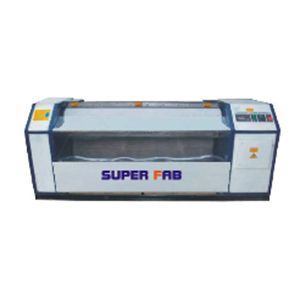
Flat Work Ironer
Get Price Quote
We are providing wide range of machines for textile, export houses and hospitals. its fixable chest design cause uniform high pressure between the roller and the chest. The chest is technically designed to afford up to 25ooC temperature of surface which maintains pressure between chest and the roll.Chest Type lroner Hi-tech electric heated ironer tor ultimate proficiency, efficiency and productivity. Salient Features VFD for variable rolls speed Less energy consumption. Higher out put. Limited space requirements. All size 304(12"), 457(18"), 610(24"),762(30"),812(32") roll diameter working width from 2 mtr. to 4.1 mtr., single roll version. Electric heated models available. Temperature adjustable to 250oC.

FLAT-WORK-IRONER Machine
Get Price Quote
Flat Work Ironer(Roller Heated)Single Roller Compact structure saves a lot of space by small covering area. Frequency conversion timing allows convenient adjusting, stable transmission and energy-saving. Heating by adopting stainless steel cylinder presents good effect.
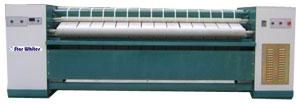
Flat Work Drying Ironer (SCH)
Get Price Quote
The IM series –multi roll industrial high productivity deep chest ironers for demanding commercial , Industrial, health care and hospital laundries. star whites steam heated ironers are solid build units designed to guarantee at all times a high productivity at a high quality level. The standard Futures Steam heating Variable speed drive with soft –start Speed control with digital read out Electronic temperature control with digital read out Pneumatically controlled compression rolls with automatic pressure adjustment Roll can be raised and locked pneumatically in an extra wide position for easy maintenance Electrical and mechanical protection devices Three phase electrical service High polished heated chest Lift off interlocked panels for easy maintenance Independent suction fans for moisture evaporation Signal lamps indicating machines operational status

Heated Flatwork Ironer
605,000 Per per Unit
1 per Unit (MOQ)

flatwork iron
Get Price Quote
Drying And Ironing of all types of Linen and Flat Textile Made up Articles.Steam,Electric or Thermic FluidHeated.Front Feed, Rear Return. Roller Size: Ø530 x 3000L

Flat Work Ironer
Get Price Quote
Single Roll, Two Roll & Multiroll

Flat Work Ironer or Calender
Get Price Quote
Flat work ironers are offered with roll diameter of 375 mm (14 - 3/4") & 610 mm (24") Length extends up to 3050 mm (120"). The ironers are available with single or multiple rolls & can have 2 fixed or variable speeds. Multi Roll calendar bridge are also heated. Roller Lifting is either pneumatic or manual with an exhaust system. Steam / electric or thermic fluid heating is offered.

Flat Work Ironer
Get Price Quote
We offer FLAT WORK IRONER. FLAT WORK IRONER WITH HEATED CHEST & REAR RETURN. ROLLER HAVING LARGE DIAMETER WITH MOVING IRONING CHEST,LARGE DIAMETER ENSURING A LONG CONTACT SURFACE , FLEXIBILITY FOR ADDITION OF ANOTHER ROLL, POWERFUL SUCTION FOR FAST DRYING FINGER GUARD FOR OPERATOR SAFETY , FLEXIBILITY FOR CHANGING OF ROLLER SPEED THROUGH VFD

FLAT WORK ROTARY IRON
Get Price Quote

Flatwork Ironer
Get Price Quote
We are offering flatwork ironer.we are the deep grooved steam/electric heated chest of flatwork ironer ensures high speed, crisp & trouble free finishing. The flatwork ironer offered by us is fitted with suction blowers to remove excess moisture. A finger guard is also provided in flatwork ironer, for absolute safety while feeding the linen. Our flatwork ironer is fitted with variable speed drives. features of flatwork ironer deep grooved steam & electric heated chestdurablehigh performancefine finishingfinger guard is also providedsuction blowers to remove excess moisture available in single & multiple rollers of various sizes

Flatwork Ironer Machine
Get Price Quote
Features The machine made with special grade material for long life, quick transmission of heat for effective drying and pressing. The lenin pressed and dried with the contact of large area of cylinders. machine designed for variable speed adjustments independent heating facility, heavy duty frame makes effective and ease to operate.